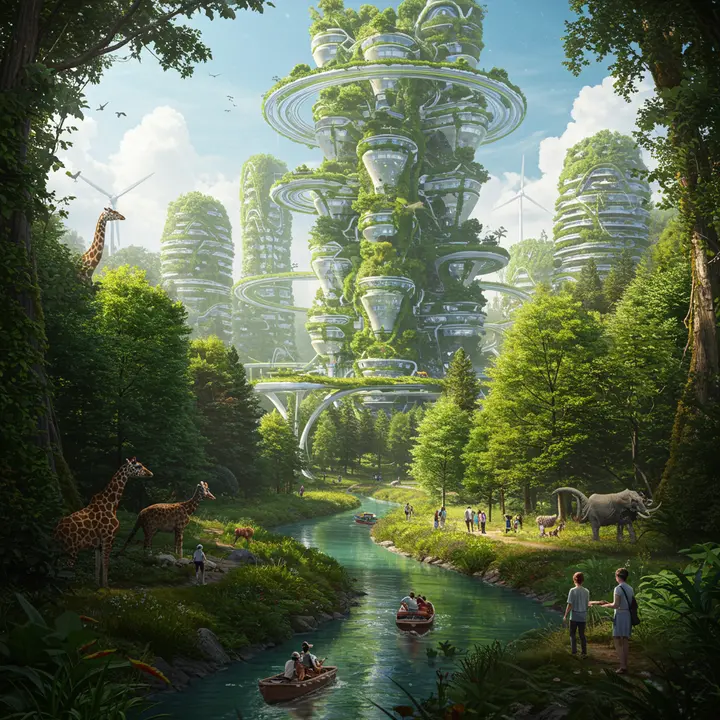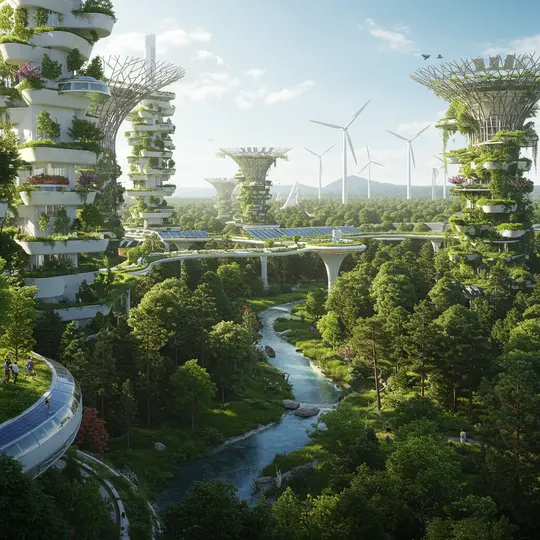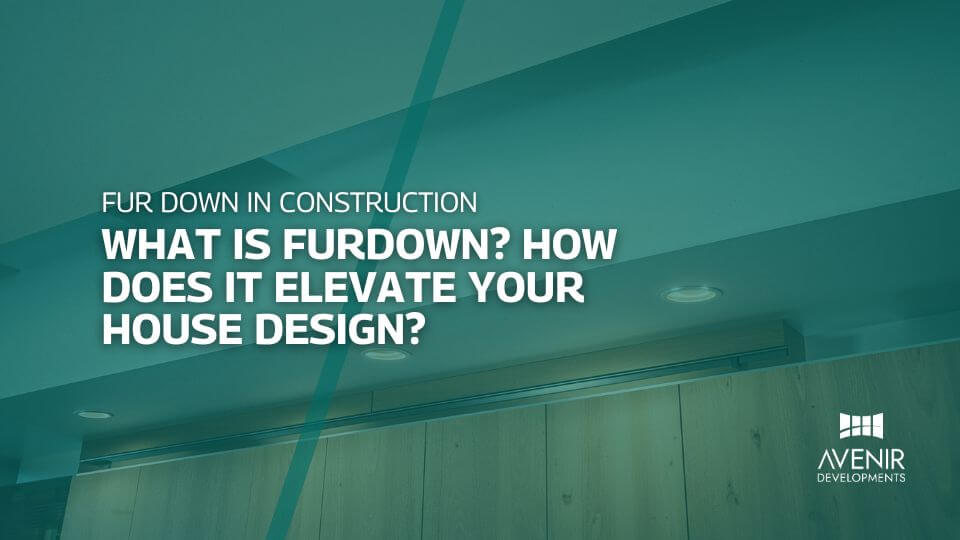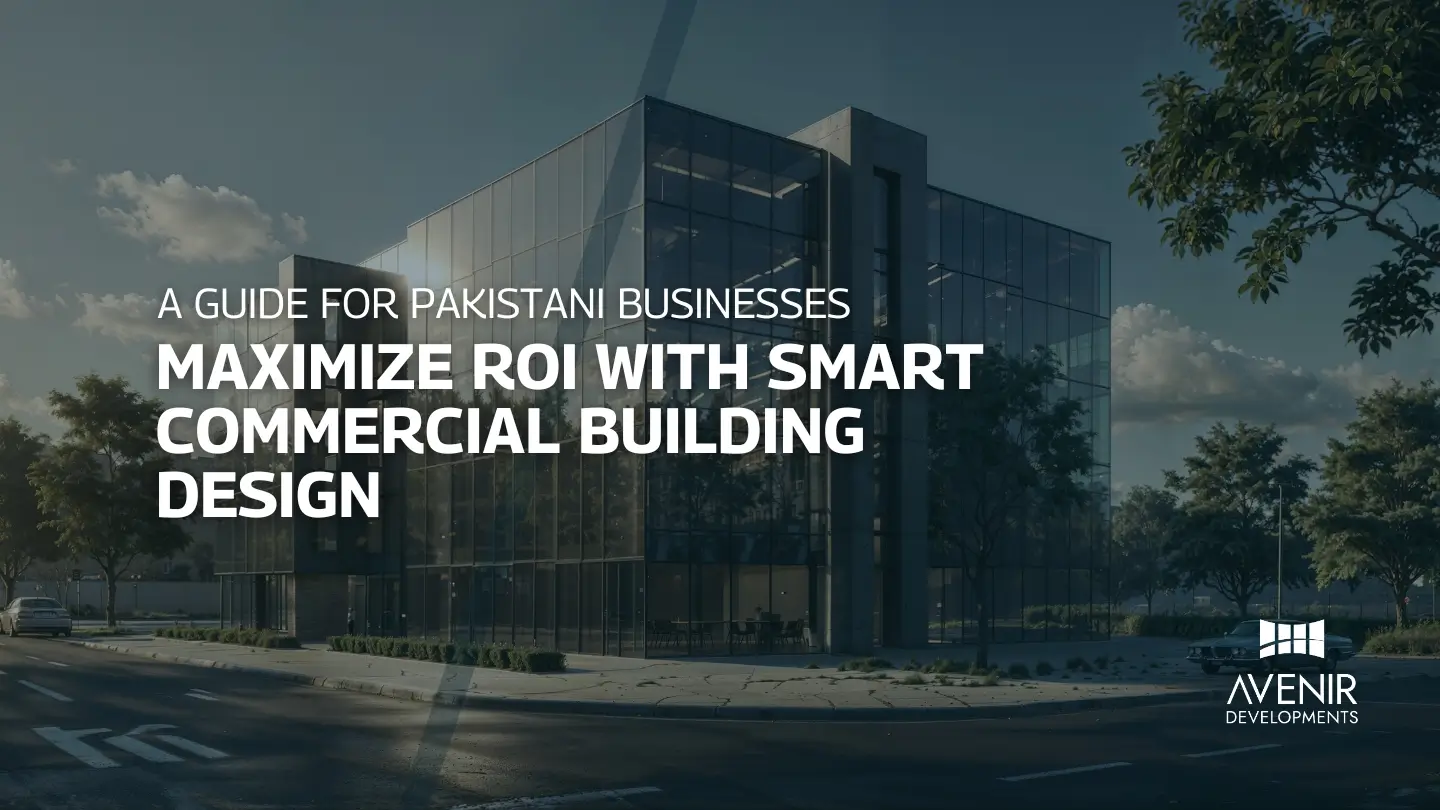What is Eco-Futurism?
Eco-futurism, in its essence, is a philosophical and cultural movement that envisions a future where technological advancement and ecological balance are intertwined. It’s about imagining a world where humans thrive in harmony with nature, leveraging innovation to solve environmental challenges rather than exacerbate them.
I’ll never forget the awe I felt standing amidst Singapore’s Supertree Grove. These towering vertical gardens, part of the city’s Gardens by the Bay, were a testament to how nature and technology could intertwine to create a breathtaking, sustainable future. That moment solidified my fascination with eco-futurism, a concept that marries ecological consciousness with futuristic vision.
But what exactly is eco-futurism? Is it just a buzzword, or does it hold the key to a truly sustainable world? In this blog, we’ll delve into the heart of eco-futurism, exploring its origins, its impact on architecture and technology, and how it’s shaping Pakistan’s and the world’s trajectory towards a greener tomorrow. We’ll uncover the latest trends, address your burning questions, and share expert tips to help you embrace an eco-futuristic mindset. By the end, you’ll not only understand this fascinating concept but also be inspired to become an active participant in building a brighter, more sustainable future.
Are you ready to envision a world where innovation and nature coexist harmoniously? Let’s embark on this journey together.
Eco-Futurism: A Brief History
While the term “eco-futurism” might seem relatively new, its roots trace back to the environmental movements of the 1960s and 70s. Thinkers like Buckminster Fuller and Paolo Soleri pioneered ideas of sustainable design and living that laid the foundation for what we now call eco-futurism.
Over the decades, eco-futurism has evolved, embracing advancements in renewable energy, green architecture, and biotechnology. It has found expression in art, literature, and popular culture, inspiring visions of a future where cities are verdant oases, transportation is emission-free, and technology serves to enhance rather than deplete natural resources.
The Importance of Eco-Futurism
In a world grappling with climate change, resource depletion, and environmental degradation, eco-futurism offers a beacon of hope. It challenges us to reimagine our relationship with the planet, to move beyond a mindset of exploitation and towards one of stewardship.
Eco-futurism is not just about survival; it’s about thriving. It’s about creating a future that is not only sustainable but also fulfilling, where human ingenuity is directed towards solving the most pressing challenges of our time.
Key Principles of Eco-Futurism
- Sustainability: At the heart of eco-futurism lies the principle of sustainability. It’s about designing systems, technologies, and lifestyles that minimize environmental impact and ensure the well-being of future generations.
- Innovation: Eco-futurism embraces innovation as a tool for positive change. It encourages the development of new technologies and approaches that promote ecological balance and enhance human well-being.
- Interconnectedness: Eco-futurism recognizes the interconnectedness of all living things. It emphasizes the importance of understanding and respecting the intricate web of life that sustains our planet.
- Optimism: Despite the daunting environmental challenges we face, eco-futurism maintains a sense of optimism. It believes in the power of human ingenuity and collective action to create a better future.

Eco-Futurism Trends and Developments
Eco-futurism is not a distant dream; it’s unfolding before our eyes, shaping the way we design cities, generate energy, and interact with our environment. Let’s explore some of the most exciting trends and developments in Pakistan and around the world.
Pakistan: A Budding Eco-Futuristic Landscape
Pakistan, despite its environmental challenges, is taking significant strides towards a greener future. The government’s recent initiatives, such as the Clean Green Pakistan Movement and the Billion Tree Tsunami Project, demonstrate a growing commitment to sustainability.
In the realm of architecture, we’re witnessing a surge in green building design. Projects like the Zero Carbon Building in Islamabad showcase innovative approaches to energy efficiency, water conservation, and the use of sustainable materials.
Renewable energy is also gaining traction, with solar and wind power projects being developed across the country. The Quaid-e-Azam Solar Park, for instance, is one of the largest solar power plants in the world.
These developments, while promising, are just the beginning. Pakistan has the potential to become a leader in eco-futurism, leveraging its abundant natural resources and youthful population to create a sustainable and prosperous future.
Global Trends: Pushing the Boundaries of Innovation
On the global stage, eco-futurism is driving innovation in diverse fields. In transportation, electric vehicles (EVs) are becoming increasingly popular, with major automakers investing heavily in EV technology. Companies like Tesla are revolutionizing the automotive industry with their cutting-edge designs and focus on sustainability.
C40 Cities is a network of the world’s megacities committed to addressing climate change. The C40 network aims to enable cities to collaborate effectively, share knowledge and drive meaningful, measurable, and sustainable action on climate change.
In agriculture, vertical farming is gaining momentum as a way to produce food in urban environments with minimal environmental impact. These high-tech farms utilize hydroponics and aeroponics to grow crops vertically, maximizing space and resource efficiency.
Even in the realm of fashion, eco-futurism is making its mark. Designers are experimenting with sustainable materials like algae and mycelium to create clothing that is both stylish and environmentally friendly.
These are just a few examples of how eco-futurism is transforming our world. As technology continues to advance and our understanding of environmental issues deepens, we can expect even more groundbreaking innovations in the years to come.
| Technology Category | Proposed Applications in Eco Futurism | Key Critiques/Challenges | Major Ethical Considerations & Governance Issues |
| Renewable Energy Systems (Solar, Wind, Geothermal, etc.) | Decarbonize energy sector, power sustainable cities and transport, reduce reliance on fossil fuels 1 | Intermittency, land use, material sourcing for panels/turbines, grid infrastructure upgrades, initial investment costs. | Equitable access to clean energy, community benefit sharing, responsible land use, lifecycle management of infrastructure. |
| Artificial Intelligence (AI) for Environmental Management | Resource optimization (energy, water, materials), predictive maintenance, climate modeling, supply chain efficiency, conservation monitoring (species tracking, anti-poaching) 2 | Data bias, algorithmic transparency, energy consumption of AI itself, job displacement, potential for misuse (surveillance). | Data privacy and ownership, algorithmic justice, accountability for AI decisions, ensuring AI serves public good vs. narrow corporate interests. |
| Advanced Biotechnology | |||
| Gene Editing for Conservation | Enhance species resilience (disease, climate change), de-extinction of keystone species, control invasive species 2 | Unintended ecological consequences (gene flow, ecosystem disruption), “playing God” concerns, technical feasibility and cost, potential for irreversible changes. | Intrinsic value of species vs. engineered organisms, ethics of intervention in evolutionary processes, public acceptance, governance of genetic information. |
| Cellular Agriculture (Cultured Meat, etc.) | Reduce environmental impact of livestock (land use, emissions, water), improve animal welfare, create novel food sources 2 | Scalability, cost-effectiveness, consumer acceptance, energy inputs for bioreactors, nutritional equivalency, texture/taste challenges. | Definition of “food” and “natural,” impact on traditional farming communities, equitable access to new food technologies, regulation of novel food products. |
| Geoengineering / Climate Engineering | |||
| Solar Radiation Management (SRM) | Reflect sunlight to rapidly cool the planet, temporarily offsetting warming effects 2 | Moral hazard (distracts from emissions cuts), termination shock (rapid warming if stopped), unpredictable regional climate impacts (e.g., monsoons), unknown ecosystem effects, does not address ocean acidification. | Unilateral deployment risks, global governance vacuum, intergenerational equity, ethics of large-scale planetary intervention, public consent, potential for weaponization. |
| Marine Cloud Brightening | Increase reflectivity of marine clouds to cool targeted areas 36 | Similar to SRM: moral hazard, localized and potentially distant weather pattern disruption, ecological impacts on marine and coastal systems, technical feasibility at scale. | Similar to SRM: governance of regional interventions, transboundary effects, accountability for negative consequences, public perception. |
| Smart City Technologies | Integrated resource management (energy, water, waste), optimized transportation, enhanced public services, improved urban resilience 1 | High infrastructure costs, data privacy and security concerns, potential for increased surveillance, digital divide (inequitable access), technological lock-in. | Citizen rights in data-driven environments, inclusivity in design and access, democratic oversight of urban technologies, preventing algorithmic bias in city services. |
| Advanced Materials (Bioplastics, Nanomaterials, Graphene, etc.) | Reduce reliance on petrochemicals, create lighter/stronger materials for efficiency, enable new functionalities (e.g., self-healing, energy harvesting) 2 | Scalability of production, cost, lifecycle impacts (biodegradability of bioplastics, toxicity of some nanomaterials), energy intensity of production for some materials. | Health and environmental safety of novel materials, responsible innovation and testing, ensuring circularity and end-of-life management, avoiding new forms of pollution. |
| Carbon Capture, Utilization & Storage (CCUS) / Direct Air Capture (DAC) | Remove CO2 from industrial sources or directly from the atmosphere to mitigate climate change 2 | High energy requirements, cost, scalability challenges, long-term storage security and liability for leaks, public acceptance, potential for enabling continued fossil fuel use (moral hazard). | Who pays for deployment and long-term stewardship, ensuring permanent sequestration, ethical implications of relying on future removal vs. present emissions cuts, land use for storage sites. |

Your Eco-Futurism FAQs, Answered
In my experience, both as an architect in Pakistan and through my global travels, I’ve encountered many questions about eco-futurism. Let’s tackle some of the most common ones:
Q: What is the difference between eco-futurism and sustainable design?
A: While both concepts share a concern for the environment, eco-futurism goes beyond sustainable design by envisioning a future where technology and ecology are deeply integrated. It’s not just about minimizing harm; it’s about leveraging innovation to create a regenerative relationship with the planet.
Q: Are eco-futuristic buildings affordable?
A: Initially, eco-futuristic buildings might have a higher upfront cost due to the use of advanced technologies and materials. However, they often result in significant long-term savings through reduced energy consumption, water usage, and maintenance costs. Additionally, government incentives and tax breaks are increasingly available to encourage green building construction.
Q: How can I incorporate eco-futurism into my daily life?
A: You don’t need to live in a high-tech eco-home to embrace eco-futurism. Start by making small changes in your daily habits, such as reducing energy consumption, conserving water, using public transportation or cycling, and supporting businesses that prioritize sustainability. You can also explore eco-friendly technologies like solar panels for your home and electric vehicles for transportation.
Q: What are some examples of eco-futuristic cities around the world?
A: Several cities are leading the way in eco-futuristic development. Masdar City in the UAE aims to be a zero-carbon, zero-waste city powered entirely by renewable energy. The city of Copenhagen in Denmark has set ambitious goals to become carbon neutral by 2025, investing in green infrastructure and sustainable transportation. Singapore, with its Supertree Grove and other eco-friendly initiatives, is another prime example of a city embracing an eco-futuristic vision.
Q: Is eco-futurism just a trend, or is it here to stay?
A: Eco-futurism is more than a trend; it’s a necessary response to the environmental challenges we face. As awareness of these challenges grows and technology advances, eco-futurism is likely to become increasingly mainstream, shaping the way we live, work, and interact with our environment.
Expert Tips for Embracing Eco-Futurism
As an architect and urban planner with experience in Pakistan and abroad, I’ve had the privilege of working on projects that embody eco-futuristic principles. Here are some expert tips I’ve gathered along the way:
- Think Beyond Sustainability: Don’t just aim to minimize your impact; strive to create a positive, regenerative relationship with the environment. Consider how your designs, technologies, and lifestyles can actively contribute to ecological restoration.
- Embrace Nature in Design: Integrate nature into your built environment whenever possible. Incorporate green roofs, living walls, and natural ventilation systems. Design spaces that maximize natural light and airflow, reducing the need for artificial lighting and air conditioning. This is something we at Avenir Developments prioritize in all our projects.
- Prioritize Energy Efficiency: Invest in energy-efficient appliances, lighting, and insulation. Consider installing solar panels or other renewable energy sources to power your home or business.
- Conserve Water: Implement water-saving measures such as rainwater harvesting, greywater recycling, and low-flow fixtures. Design landscapes that require minimal irrigation and prioritize native plants adapted to the local climate.
- Support Sustainable Transportation: Opt for public transportation, cycling, or walking whenever possible. If you need a car, consider an electric or hybrid vehicle. Advocate for better public transportation infrastructure and bike-friendly policies in your community.
- Choose Sustainable Materials: When building or renovating, prioritize sustainable materials like bamboo, reclaimed wood, and recycled metal. Look for products with low environmental impact certifications.
- Reduce, Reuse, Recycle: Minimize waste by reducing consumption, reusing items whenever possible, and recycling materials that cannot be reused. Compost organic waste to enrich your soil and reduce landfill burden.
- Advocate for Change: Support policies and initiatives that promote sustainability and eco-futurism. Engage with your local community and elected officials to advocate for a greener future.
- Stay Informed: Keep up with the latest developments in eco-futuristic technology and design. Read books, articles, and blogs on the topic. Attend conferences and workshops to learn from experts and connect with like-minded individuals.
- Think Long-Term: Eco-futurism is not just about the present; it’s about creating a legacy for future generations. Consider the long-term impacts of your choices and actions on the environment and society.
Our Collective Eco-Futuristic Journey
Eco-futurism is not merely a trend; it’s an evolving narrative that we’re all a part of. As we’ve explored, it’s a movement that’s gaining momentum in Pakistan and around the world, reshaping the way we design our cities, power our homes, and interact with our environment.
The choices we make today will determine the kind of future we create. Will it be a future of ecological devastation and resource scarcity, or one of harmony, abundance, and innovation? Eco-futurism calls upon us to choose the latter.
As we stand on the precipice of a new era, let’s embrace the principles of eco-futurism – sustainability, innovation, interconnectedness, and optimism. Let’s envision a greener tomorrow and take bold steps to make it a reality.
Whether you’re an architect, an entrepreneur, a student, or simply a concerned citizen, you have a role to play in building an eco-futuristic world. Start by incorporating the tips we’ve shared into your daily life and advocate for change in your community. Together, we can create a future that is not only sustainable but also vibrant, equitable, and fulfilling for all.
Ready to embark on your eco-futuristic journey? Contact Avenir Developments on WhatsApp or call +923001101103 for professional services and consultancy in architecture, interior design, house construction, and custom home building. Let’s build a greener tomorrow, together.







